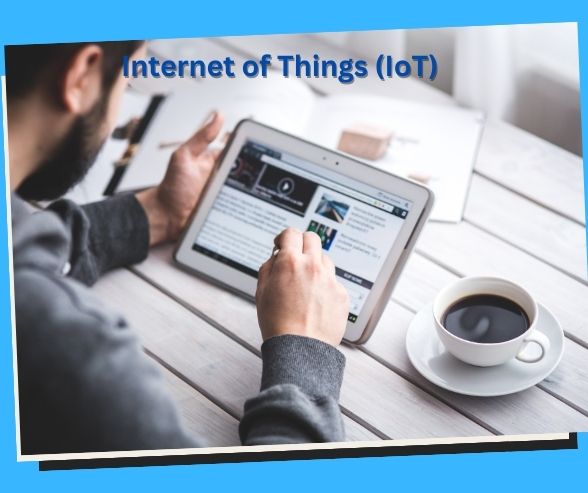
Securing the Future: Integrating Blockchain and IoT for Enhanced Security
Discover how integrating blockchain with IoT can revolutionize security measures, safeguarding your digital assets like never before.
Fortifying Connectivity: A Comprehensive Guide to Integrating Blockchain with IoT for Enhanced Security
In today’s interconnected world, the Internet of Things (IoT) has become ubiquitous, revolutionizing industries and transforming daily life. However, with the proliferation of IoT devices comes the need for robust security measures to protect sensitive data and ensure the integrity of networks. Blockchain technology, renowned for its decentralized and immutable nature, offers a powerful solution to enhance security in IoT deployments. In this guide, we’ll delve into the intricacies of integrating blockchain with IoT, exploring the benefits, challenges, and practical tips for leveraging this synergistic combination to fortify connectivity and safeguard digital assets.
Understanding the Basics: IoT and Blockchain Unraveled 🌐
Before we delve into the integration of IoT and blockchain, let’s break down the fundamentals of each technology:
- Internet of Things (IoT): IoT refers to a network of interconnected devices embedded with sensors, actuators, and connectivity capabilities, enabling them to collect, exchange, and analyze data. These devices span a wide range of applications, from smart home appliances and wearables to industrial machinery and autonomous vehicles.
- Blockchain Technology: Blockchain is a distributed ledger technology that enables secure, transparent, and immutable record-keeping of transactions across a network of computers. Each transaction is cryptographically linked and timestamped, creating a tamper-resistant chain of blocks that cannot be altered or deleted.
The Case for Integration: Enhancing Security with Blockchain 🔒
While IoT offers unparalleled convenience and efficiency, it also introduces new security challenges, including data privacy risks, device vulnerabilities, and potential points of failure. By integrating blockchain with IoT, organizations can address these challenges and enhance security in several ways:
- Data Integrity: Blockchain’s immutable ledger ensures that data collected from IoT devices remains tamper-proof and trustworthy, preventing unauthorized modification or manipulation.
- Authentication and Authorization: Blockchain enables secure authentication and authorization mechanisms for IoT devices, ensuring that only authorized users and devices can access sensitive data or perform actions on the network.
- Decentralization: By decentralizing control and eliminating single points of failure, blockchain reduces the risk of data breaches, denial-of-service attacks, and other cyber threats targeting centralized IoT systems.
- Smart Contracts: Blockchain’s smart contract functionality allows for the automation of business processes and transactions, enabling secure, transparent, and self-executing agreements between IoT devices and stakeholders.
Overcoming Challenges: Practical Considerations for Integration 🛠️
While the benefits of integrating blockchain with IoT are clear, the process presents several challenges and considerations. Here are some practical tips for overcoming these challenges:
- Scalability: Choose a blockchain platform that offers scalability and throughput suitable for IoT applications, such as permissioned blockchains or layer-2 scaling solutions like sidechains or off-chain protocols.
- Interoperability: Ensure compatibility and interoperability between IoT devices and blockchain networks by adopting industry standards, protocols, and APIs for data exchange and communication.
- Resource Constraints: Optimize resource usage and minimize overhead for IoT devices by implementing lightweight blockchain protocols, consensus mechanisms, and data storage solutions tailored to constrained environments.
- Privacy and Compliance: Address privacy concerns and regulatory requirements by implementing privacy-preserving techniques, such as zero-knowledge proofs or homomorphic encryption, to protect sensitive IoT data while maintaining transparency and auditability.
- Security Audits: Conduct regular security audits and vulnerability assessments of both IoT devices and blockchain networks to identify and mitigate potential threats and weaknesses proactively.
Getting Started: Steps to Integrate Blockchain with IoT 🚀
Now that you understand the benefits, challenges, and use cases of integrating blockchain with IoT, let’s outline the steps to get started:
- Identify Use Case: Define the specific use case or problem you want to address with blockchain-enabled IoT, considering factors such as industry, application, and desired outcomes.
- Select Blockchain Platform: Choose a blockchain platform that aligns with your requirements, such as Ethereum, Hyperledger Fabric, or IOTA, based on factors like scalability, interoperability, and consensus mechanism.
- Design Architecture: Design the architecture of your blockchain-enabled IoT solution, including components such as IoT devices, blockchain nodes, smart contracts, and data storage.
- Develop Smart Contracts: Write and deploy smart contracts to define the rules and logic governing interactions between IoT devices and the blockchain network, such as data exchange, access control, and transaction settlement.
- Integrate IoT Devices: Connect IoT devices to the blockchain network using APIs, SDKs, or middleware solutions that facilitate secure communication and data exchange between devices and the blockchain.
- Test and Deploy: Test your blockchain-enabled IoT solution in a controlled environment to ensure functionality, reliability, and security. Once validated, deploy the solution to production and monitor its performance and effectiveness over time.
Securing the Future of IoT with Blockchain 🌐
Integrating blockchain with IoT offers a compelling solution to enhance security, transparency, and trust in interconnected systems, unlocking new possibilities for innovation and value creation. By leveraging blockchain’s decentralized architecture, immutability, and smart contract capabilities, organizations can mitigate risks, streamline processes, and foster collaboration across diverse ecosystems.
As you embark on your journey to integrate blockchain with IoT, remember to approach the process thoughtfully, considering the unique requirements and challenges of your use case. By staying informed, collaborating with experts, and embracing a mindset of experimentation and continuous improvement, you can harness the power of blockchain to secure the future of IoT and drive positive change in the digital landscape.
Integrating blockchain with IoT may seem complex, but with the right approach and understanding, it’s within reach for organizations of all sizes and industries. By following the steps outlined in this guide and leveraging the benefits of blockchain technology, you can enhance security, transparency, and trust in your IoT deployments, paving the way for a safer, more resilient digital future. Start your journey to blockchain-enabled IoT today and unlock the full potential of interconnected systems for innovation and growth.
💪 Benefits of Integrating Blockchain with IoT for Enhanced Security
- Immutable Data Integrity: Blockchain’s distributed ledger ensures that once data is recorded, it cannot be altered or tampered with, providing a verifiable record of transactions and events in IoT environments.
- Decentralized Architecture: By decentralizing control and eliminating single points of failure, Blockchain enhances the resilience and security of IoT networks against attacks and breaches.
- Transparency and Traceability: Blockchain’s transparent and auditable nature enables stakeholders to track the flow of data and verify its origin and authenticity, fostering trust and accountability in IoT transactions.
- Secure Identity Management: Blockchain-based identity solutions offer secure and decentralized authentication mechanisms, mitigating the risk of identity theft and unauthorized access to IoT devices and data.
- Smart Contract Automation: Blockchain-enabled smart contracts automate and enforce agreements between IoT devices, ensuring that transactions are executed securely and transparently without the need for intermediaries.
- Data Privacy and Confidentiality: Blockchain’s cryptographic techniques and permissioned access mechanisms safeguard sensitive IoT data, protecting privacy and confidentiality in decentralized networks.
- Resilient Supply Chains: By integrating Blockchain with IoT, organizations can create transparent and secure supply chain ecosystems, enabling real-time tracking of goods and ensuring authenticity and integrity throughout the supply chain.
- Fraud Prevention and Detection: Blockchain’s transparent and immutable ledger deters fraudulent activities and enables real-time detection and mitigation of anomalies in IoT transactions and data streams.
- Compliance and Regulatory Compliance: Blockchain-based audit trails and tamper-proof records facilitate compliance with regulatory requirements and industry standards, reducing the risk of fines and penalties for non-compliance.
- Cost Savings and Efficiency: By reducing reliance on intermediaries, automating processes, and minimizing the risk of security incidents, integrating Blockchain with IoT can lead to cost savings and operational efficiencies for organizations.
🌐 Case Studies: Real-life Examples of Blockchain and IoT Integration for Enhanced Security
- Secure Supply Chain Management: Walmart implemented a Blockchain-based system to track the provenance of food products in its supply chain. By integrating IoT sensors and Blockchain technology, Walmart ensures transparency and traceability, enhancing food safety and security.
- Medical Device Authentication: Chronicled developed a Blockchain platform to authenticate and track medical devices throughout their lifecycle. By embedding unique identifiers in IoT devices and recording transactions on the Blockchain, Chronicled enhances security and prevents counterfeiting in the healthcare industry.
- Energy Grid Security: LO3 Energy deployed a Blockchain-based microgrid system to enable peer-to-peer energy transactions in local communities. By integrating IoT sensors and Blockchain technology, LO3 Energy ensures secure and transparent energy trading, reducing reliance on centralized utilities and enhancing grid resilience.
- Asset Tracking and Management: IBM developed a Blockchain solution for tracking high-value assets across global supply chains. By combining IoT sensors and Blockchain technology, IBM enables real-time tracking and verification of asset movements, reducing the risk of theft, loss, and fraud.
- Smart Contract Automation: Slock.it created a Blockchain platform for automating rental agreements and payments for shared assets such as rental cars and apartments. By integrating IoT devices and Blockchain technology, Slock.it ensures secure and tamper-proof transactions, enabling seamless peer-to-peer rentals without intermediaries.
- Digital Identity Management: Civic developed a Blockchain-based identity verification platform to protect against identity theft and fraud. By integrating IoT biometric sensors and Blockchain technology, Civic provides secure and decentralized identity verification for individuals and organizations.
- Real Estate Tokenization: Propy implemented a Blockchain platform for tokenizing real estate assets and facilitating property transactions. By integrating IoT sensors and Blockchain technology, Propy enables secure and transparent real estate transactions, reducing the risk of fraud and disputes.
- Vehicle Lifecycle Management: CarVertical developed a Blockchain solution for tracking the lifecycle of used cars and verifying their history. By integrating IoT sensors and Blockchain technology, CarVertical provides transparent and trustworthy vehicle history reports, enhancing trust and confidence among buyers and sellers.
- Intellectual Property Protection: WISeKey created a Blockchain platform for securing and managing digital identities and intellectual property rights. By integrating IoT devices and Blockchain technology, WISeKey enables secure and tamper-proof authentication and management of digital assets.
- Supply Chain Traceability: VeChain implemented a Blockchain platform for tracking and tracing products throughout the supply chain. By integrating IoT sensors and Blockchain technology, VeChain ensures transparency and authenticity, enabling consumers to verify the origin and quality of products.
📝 Key Takeaways: Essential Strategies for Integrating Blockchain with IoT for Enhanced Security
- Identify Use Cases: Identify specific use cases and scenarios where integrating Blockchain with IoT can address security challenges and enhance trust and transparency.
- Select the Right Platform: Choose a Blockchain platform that meets your security, scalability, and interoperability requirements, and supports integration with IoT devices and protocols.
- Design Secure Architectures: Design secure and resilient architectures that leverage Blockchain’s decentralized nature and cryptographic techniques to protect IoT data and transactions from unauthorized access and tampering.
- Integrate IoT Sensors: Integrate IoT sensors and devices with Blockchain platforms to capture and transmit data securely and verifiably, ensuring the integrity and authenticity of IoT data streams.
- Implement Identity Management: Implement Blockchain-based identity management solutions to authenticate and authorize IoT devices and users, preventing unauthorized access and ensuring secure interactions.
- Leverage Smart Contracts: Leverage Blockchain-enabled smart contracts to automate and enforce agreements between IoT devices, ensuring that transactions are executed securely and transparently without the need for intermediaries.
- Ensure Data Privacy: Implement privacy-preserving techniques and encryption mechanisms to protect sensitive IoT data from unauthorized disclosure and ensure compliance with data protection regulations.
- Establish Consensus Mechanisms: Establish consensus mechanisms and governance models that ensure the integrity and validity of transactions recorded on the Blockchain, preventing malicious actors from compromising the network.
- Monitor and Audit: Monitor Blockchain transactions and IoT data streams in real-time and conduct regular audits to detect anomalies and security incidents, ensuring the ongoing integrity and security of the system.
- Stay Updated: Stay informed about the latest developments and best practices in Blockchain and IoT security, and continuously update your strategies and technologies to adapt to evolving threats and challenges.
❓ FAQs: Addressing Common Concerns About Integrating Blockchain with IoT for Enhanced Security
- What is the role of Blockchain in IoT security?
Blockchain provides a tamper-proof and transparent ledger for recording transactions and data exchanges between IoT devices, enhancing security, trust, and transparency in IoT ecosystems. - How does Blockchain ensure data integrity in IoT environments?
Blockchain’s distributed ledger ensures data integrity by recording transactions in a decentralized and immutable manner, preventing tampering and unauthorized modifications to IoT data. - Can Blockchain prevent IoT devices from being hacked?
While Blockchain enhances security and trust in IoT ecosystems, it cannot prevent IoT devices from being hacked. However, it can mitigate the impact of security breaches by providing secure and transparent transaction records and identity management capabilities. - Is Blockchain suitable for all IoT applications?
While Blockchain offers benefits for enhancing security and trust in many IoT applications, it may not be suitable for all use cases due to factors such as scalability, performance, and cost considerations. - What are the challenges of integrating Blockchain with IoT?
Challenges include interoperability between Blockchain platforms and IoT devices, scalability of Blockchain networks, complexity of implementing secure architectures, and regulatory compliance requirements. - How do I choose the right Blockchain platform for integrating with IoT?
Consider factors such as security features, scalability, interoperability, developer support, and community adoption when choosing a Blockchain platform for integrating with IoT. - Can I use public Blockchain networks for IoT applications?
While public Blockchain networks offer transparency and decentralization, they may not be suitable for all IoT applications due to privacy, scalability, and cost considerations. Private or permissioned Blockchain networks may be more appropriate for certain use cases. - How do I ensure compliance with data protection regulations when using Blockchain with IoT?
Implement privacy-enhancing techniques such as encryption, pseudonymization, and access controls to protect sensitive IoT data and ensure compliance with data protection regulations such as GDPR. - What are some examples of successful Blockchain and IoT integration projects?
Successful examples include supply chain management, healthcare data exchange, energy grid optimization, digital identity management, and asset tracking applications that leverage the security and transparency of Blockchain technology in IoT environments. - What are the future trends in Blockchain and IoT integration?
Future trends include the adoption of hybrid Blockchain architectures, the emergence of interoperable standards and protocols, the integration of artificial intelligence and machine learning with Blockchain and IoT, and the development of scalable and energy-efficient Blockchain solutions for IoT applications.
🚀 Conclusion: Building a Secure and Trustworthy IoT Future with Blockchain Integration
In conclusion, the integration of Blockchain with IoT holds immense promise for transforming security and trust in our increasingly connected world. By leveraging Blockchain’s immutable ledger and decentralized architecture, organizations can enhance data integrity, transparency, and privacy in IoT ecosystems, paving the way for a more secure and trustworthy digital future. So, let’s harness the power of this transformative synergy and embark on a journey to fortify our digital fortress against cyber threats and breaches, ensuring a safer and more resilient IoT landscape for generations to come!
Key Phrases
- Blockchain integration with IoT
- Enhancing IoT security with blockchain
- Blockchain-powered IoT security
- Decentralized authentication for IoT
- Securing IoT devices with blockchain
- Data encryption for IoT security
- Future-proofing IoT with blockchain
- Cybersecurity with Blockchain and IoT
- Blockchain-driven IoT protection
- Strengthening IoT security through blockchain
Hashtags
- #BlockchainIoTSecurity
- #EnhancedSecurity
- #Cybersecurity
- #BlockchainIntegration
- #DataPrivacy
- #FutureTech
- #IoTProtection
- #DecentralizedAuthentication
- #SecureConnectedDevices
- #EmergingThreats
Save/Share this story with QR CODE
Disclaimer
This article is for informational purposes only and does not constitute endorsement of any specific technologies or methodologies and financial advice or endorsement of any specific products or services.
📩 Need to get in touch?
Feel free to Email Us for comments, suggestions, reviews, or anything else.
We appreciate your reading. 😊Simple Ways To Say Thanks & Support Us:
1.) ❤️GIVE A TIP. Send a small donation thru Paypal😊❤️
Your DONATION will be used to fund and maintain NEXTGENDAY.com
Subscribers in the Philippines can make donations to mobile number 0917 906 3081, thru GCash.
3.) 🛒 BUY or SIGN UP to our AFFILIATE PARTNERS.
4.) 👍 Give this news article a THUMBS UP, and Leave a Comment (at Least Five Words).
AFFILIATE PARTNERS

World Class Nutritional Supplements - Buy Highest Quality Products, Purest Most Healthy Ingredients, Direct to your Door! Up to 90% OFF.
Join LiveGood Today - A company created to satisfy the world's most demanding leaders and entrepreneurs, with the best compensation plan today.



 Business Technology, Finance Technology & Information Technology
Business Technology, Finance Technology & Information Technology





